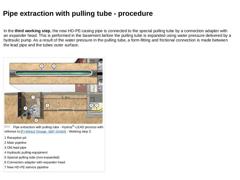
|

|
In the third working step, the new HD-PE-casing pipe is connected to the special pulling tube by a connection adapter with an expander head. This is performed in the basement before the pulling tube is expanded using water pressure delivered by a hydraulic pump. As a result of the water pressure in the pulling tube, a form-fitting and frictional connection is made between the lead pipe and the tubes outer surface. (Image: Pipe extraction with pulling … |
|
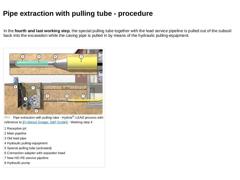
|

|
In the fourth and last working step, the special pulling tube together with the lead service pipeline is pulled out of the subsoil back into the excavation while the casing pipe is pulled in by means of the hydraulic pulling-equipment. (Image: Pipe extraction with pulling tube - Hydros®-LEAD process with reference to [FI-Weiss] [Image: S&P GmbH] - Working step 4) |
|
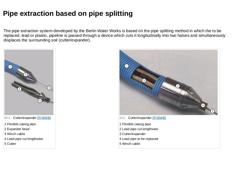
|

|
The pipe extraction system developed by the Berlin Water Works is based on the pipe splitting method in which the to be replaced, lead or plastic, pipeline is passed through a device which cuts it longitudinally into two halves and simultaneously displaces the surrounding soil (cutter/expander). |
|
(Image: Cutter/expander [FI-BWB]) |
(Image: Cutter/expander [FI-BWB]) |
|
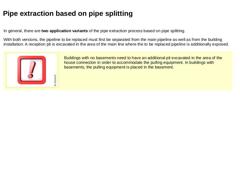
|

|
In general, there are two application variants of the pipe extraction process based on pipe splitting. With both versions, the pipeline to be replaced must first be separated from the main pipeline as well as from the building installation. A reception pit is excavated in the area of the main line where the to be replaced pipeline is additionally exposed. |
|
(Image: Attention!)
Buildings with no basements need to have an additional pit excavated … |
|
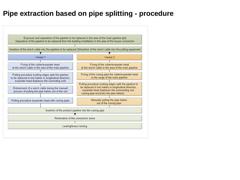
|

(Image: Pipe extraction based on pipe splitting - Working steps) |
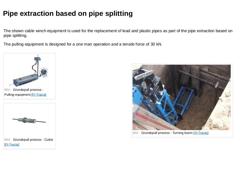
|

|
The shown cable winch equipment is used for the replacement of lead and plastic pipes as part of the pipe extraction based on pipe splitting.
The pulling equipment is designed for a one man operation and a tensile force of 30 kN. |
|
(Image: Grundopull process - Pulling-equipment [FI-Tracta]) |
|
(Image: Grundopull process - Cutter [FI-Tracta]) |
|
(Image: Grundopull process - Turning boom [FI-Tracta]) |
|
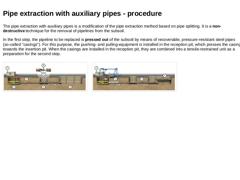
|

The pipe extraction with auxiliary pipes is a modification of the pipe extraction method based on pipe splitting. It is a non-destructive technique for the removal of pipelines from the subsoil. In the first step, the pipeline to be replaced is pressed out of the subsoil by means of recoverable, pressure-resistant steel pipes (so-called "casings"). For this purpose, the pushing- and pulling-equipment is installed in the reception pit, which presses … |
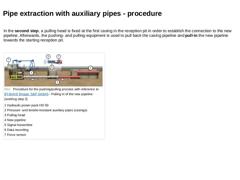
|

|
In the second step, a pulling head is fixed at the first casing in the reception pit in order to establish the connection to the new pipeline. Afterwards, the pushing- and pulling-equipment is used to pull back the casing pipeline and pull-in the new pipeline towards the starting reception pit. (Image: Procedure for pushing/pulling process with reference to [FI-Bohrt] [Image: S&P GmbH] - Pulling in of the new pipeline (working step 2)) |
|
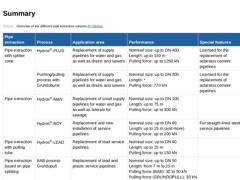
|

(Table: Overview of the different pipe extraction variants) |
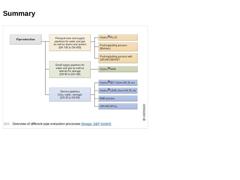
|

(Image: Overview of different pipe extraction processes) |
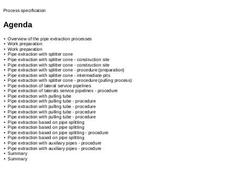
|

|
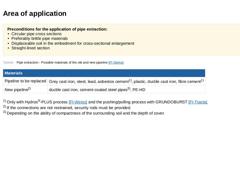
|

Preconditions for the application of pipe extraction:-
Circular pipe cross sections
-
Preferably brittle pipe materials
-
Displaceable soil in the embedment for cross-sectional enlargement
-
Straight-lined section
(Table: Pipe extraction - Possible materials of the old and new pipeline [FI-Steina])
|
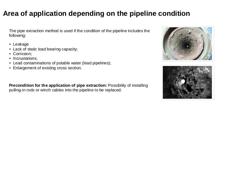
|

|
The pipe extraction method is used if the condition of the pipeline includes the following: -
Leakage
-
Lack of static load bearing capacity;
-
Corrosion;
-
Incrustations;
-
Lead contaminations of potable water (lead pipelines);
-
Enlargement of existing cross section.
Precondition for the application of pipe extraction: Possibility of installing pulling-in rods or winch cables into the pipeline to be replaced. |
|
(Image: Steel potable water pipe with … |
|
|
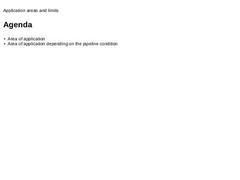
|

|
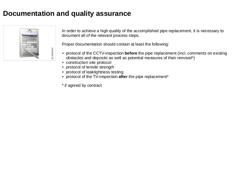
|

|
(Image: Documentation) |
In order to achieve a high quality of the accomplished pipe replacement, it is necessary to document all of the relevant process steps.
Proper documentation should contain at least the following: -
protocol of the CCTV-inspection before the pipe replacement (incl. comments on existing obstacles and deposits as well as potential measures of their removal*)
-
construction site protocol
-
protocol of tensile strength
-
protocol …
|
|
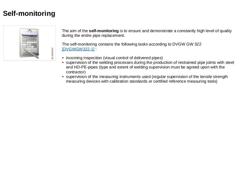
|

|
(Image: Documentation) |
The aim of the self-monitoring is to ensure and demonstrate a constantly high level of quality during the entire pipe replacement.
The self-monitoring contains the following tasks according to DVGW GW 322 [DVGWGW322-1] : -
incoming inspection (visual control of delivered pipes)
-
supervision of the welding processes during the production of restrained pipe joints with steel and HD-PE-pipes (type and extent of welding supervision …
|
|
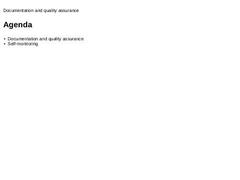
|

|
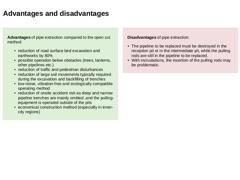
|

Advantages of pipe extraction compared to the open cut method: -
reduction of road surface bed excavation and earthworks by 80%
-
possible operation below obstacles (trees, lanterns, other pipelines etc.)
-
reduction of traffic and pedestrian disturbances
-
reduction of large soil movements typically required during the excavation and backfilling of trenches
-
low-noise, vibration-free and ecologically compatible operating method
-
reduction of onsite accident …
|
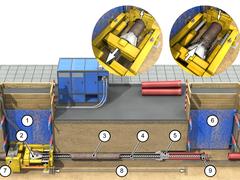
|
This module deals with the trenchless replacement of gas, water, wastewater pipelines by means of the pipe extraction method. The pipe extraction methods with split cone, pull hose, auxiliary pipe, and based on the split and cut method are presented. After completing this module, you will have knowledge of: - areas and limitations of use
- advantages and disadvantages of this replacement method.
|